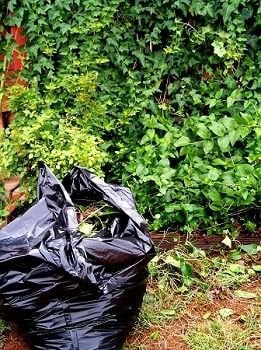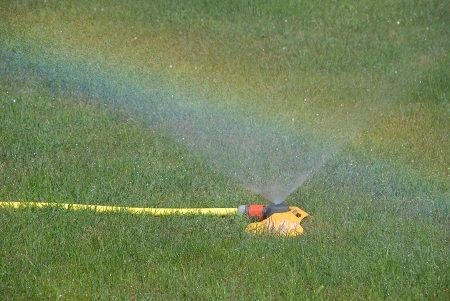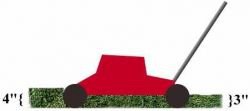Grasscycling--Easy way to a healthier, greener lawn

Grasscycling can save up to one-third your mowing time
Grasscycling means recycling your grass clippings right into your lawn. It is an increasingly popular method of lawn care that will keep your lawn looking its best at a fraction of the cost and time you usually spend during the mowing season.
How much time do you spend each week cutting your grass, stopping every few turns to remove the grass catcher, shake the clippings into a garbage sack, and reattach the bag?
Remove the grass catcher and cut mowing time by up to 1/3
A morgueFile Free Photo
You can save as much as one-third of your total mowing time by removing that grass catcher and recycling your clippings directly into your lawn.
Plus, you'll reap benefits in a healthier, more luxurious lawn, while lowering your fertilizer and water bills.
Learn just how easy it is to grasscycle your lawn clippings right here. You'll also find links to some of the best chemical-free lawn care wisdom currently available, and a host of other resources, including in-depth reading if you're interested in the science behind the process.
While I've included links to some of the best books on the subject, you don't have to buy a single one. Check them out at your local library instead.
Every time you mow your lawn - Save the easy Grasscyling way

Yard waste in trash bag
a morgueFile Free Photo
If your lawn is typical, by the time you've finished your weekly mowing, you've hauled 70-140 pounds of filled garbage sacks to the curb.
Trucked away week after week, those bags, along with your neighbors', contribute about half the waste going to the landfill between May and September. Collection and landfill costs rise, passed back to you in higher fees.
By letting your clippings lie, you save your back and your wallet. Not only do you help yourself, but you are a good citizen, helping your community as well.
See yourself in these chairs? - When you Grasscycle, you have more time to relax

Two Adirondack chairs on the edge of the lawn, facing the woods
a morgueFile Free Photo
You can save as much as one-third of your lawn mowing time over an entire season by letting grass clippings lie.
While you relax, those grass clippings are settling between the living leaves, locking in moisture, shading the roots from the hot sun, and beginning to break down and feed nitrogen and other nutrients to your lawn.
You won't need to fertilize as often, saving you even more time and money. You won't need to water as often, or as long, either, saving even more time and $$$.
Make yours a chemical-free lawn - Safe for your wee ones
When I became homeowner, this book quickly became a dog-eared, lawn-care companion that helped me and my family develop good stewardship practices and enjoy a beautiful yard. Much of what you see here, I first learned in this handy, easy-to-read guide.

Grasscycling saves!
When you grasscycle, you save both time and money because you water and fertilize less.
Grasscycling is easy - Cut the sweat
4 ways to save on your water bill and get a greener lawn

Avoid watering in the heat of the day
a morgueFile Free Photo
- Water only when the grass is dry--most lawns need no more than one inch water per week, even in arid areas of the country.
- Irrigate in the morning, between six and ten, before the sun is high to avoid losing up to 60 percent of the water to evaporation. Use a low sprinkler head that saturates the ground, rather than a high shower. On a hot day, most of the water from a high sprinkler evaporates before it can sink into the soil.
- Water deeply and less frequently. Deep, healthy roots don't require as much water. Plus, they deliver more lush, green-enhancing nutrients to the grass blades (leaves) above the soil. Light, frequent watering encourages shallow roots and may lead to disease and stress injury to the grass plants.
- Water in the evening or at night. If you live in a dry climate, such as the Rocky Mountain states or the southwest, save even more by watering at night. This won't work if you live in a moist climate, where a damp lawn after dark is more prone to disease.
One 40-pound bag of synthetic fertilizer contains the fossil-fuel equivalent of approximately 2.5 gallons of gasoline
— National Resources Defense Council at http://www.nrdc.org/living/yardgarden/organic-lawn-care.asp
With Grasscycling, you'll use one-third less fertilizer
Fewer Saturdays pushing the fertilizer hopper
As grass clippings break down, they release moisture and nutrients into the soil, including the nitrogen that keeps your lawn green and lush. You'll need to fertilize less, about one-third less, according to studies.
Less is more! Most grasses require modest levels of nitrogen for good color and controlled growth. Excess fertilizer makes grass grow faster, requiring more mowing, and does not necessarily improve the health of the plant.
For optimum lawn health, follow this schedule.
- Fertilize only in the fall. A fall application boosts spring growth.
- Fertilize again in spring, but only if the lawn needs it.
- For slower, more uniform growth, choose fertilizers with the label "water insoluble nitrogen" or "slow release nitrogen." These increase the amount of time the grass can use the nutrient.
- Let clippings do the job through the summer.
For a safe, healthy lawn, go organic
This organic-lawn-user's guide will pay for itself quickly. Check it out! Follow the link and electronically "thumb through" just as you would in the book store.

Mowing for one hour with a gasoline-powered mower generates the same amount of pollution as driving a car for 20 miles, according to the Environmental Protection Agency (EPA).
— National Resources Defense Council - See http://www.nrdc.org/living/yardgarden/organic-lawn-care.asp
Grasscycling cuts your mowing time by about one-third
Even though mowing high requires mowing a little more often during the peak growing cycle--about every five days--studies conducted by the University of Idaho and elsewhere show that most grasscycling homeowners reduce overall mowing time by about one-third over the course of a season. The following tips are key to saving time, money and maintaining a healthy lawn.
Mow when the grass is dry - Wet clippings may lie on top of the grass. Dry clippings settle between grass plants more readily, giving a clean, neat appearance to your lawn and minimizing the tracking of that sticky stuff into your house.
Keep your mower blade sharp to keep your lawn healthy - A dull blade tears the grass blade, injures the plant, and causes ragged, brown edges on the top of the turf, inviting disease. Check your blade after each use. Get it sharpened when it dulls or has significant nicks.

For a healthier lawn, mow high and a little more frequently
You'll still save mowing time over the course of your lawn's growing season
Set your mower height to 3"-4" and trim no more than 1/2-3/4" each time. Mowing high reduces shock to the grass plant because less of the blade is removed. Grass looks healthier because it is, from the roots up. Short, dry clippings fall between the grass blades, where they shade the roots and soil, retaining moisture, while breaking down unseen.
Grasscycling is even easier with a mulching mower - Take a look at the Earthwise Mulching Mower
You can grasscyle with any mower, but if you're planning to buy a new mower, consider a mulching mower. Mulching or recycling mowers, as well as non-polluting reel mowers, make quick work of shredding and scattering clippings so they fall between the grass plants.

Will grasscycling cause thatch?
GRASSCYCLING DOES NOT CAUSE THATCH
Thatch is an accumulation of dead rhizomes, roots and stems, which do not decay quickly. Cut grass decomposes quickly and does not cause thatch build-up.
Tip
Wear golf shoes while mowing. The spikes help to aerate your lawn, which improves soil health.
Aerate your lawn - But don't bother with a big noisy machine
Wear golf shoes when you mow to aerate the lawn and keep the soil fauna well oxygenated.


Grasscycling is good for your community and the environment
Good citizens grasscycle!
Grass recycling saves municipal costs, which we all pay for one way or another. It also reduces the amount of toxic runoff into our streams and rivers caused by excessive fertilizing.
- Curbside clippings collection increases trash hauling and handling costs, which you'll see in your trash bill.
- Grass clippings can represent from 20 to 50 percent of the solid waste going to landfills in the spring and summer, and cities across the country are fast running out of new land to fill.
- Clippings contribute to landfill gas and leaching, putting our groundwater and air at risk and raising environmental management costs.
- Grass clippings increase odors during storage, collection, and disposal of trash.
- Runoff from a heavily fertilized lawn carries fertilizers to our rivers and streams, putting fish and wildlife at risk.
Grasscycling is for the birds! - and the soil and the water and the air and all of us
Will you switch to grasscycling this year?
Teaming with microbes: A gardener's guide to the soil food web - Like the play on words?
Here's what one reviewer had to say about this intriguing look beneath the crust:
"Sure, it's a gardening book, but it has all the drama and suspense of an extraterrestrial thriller. A cast of characters without eyeballs or backbones. Battle scenes with bizarre creatures devouring one another. Only this book is about as terrestrial as it gets."
Debra McKinney, Anchorage Daily News, September 14, 2006


Summary
How recycling your grass clippings saves lawn care costs
Grass clippings shade roots, cool the soil, return moisture and nutrients to the soil when they break down, add moisture-holding organic matter, and reduce lawn watering needs.
- Grass clippings supply up to one-third of a lawn's nitrogen fertilizer needs
- Clippings decompose rapidly, feeding soil organisms that keep soil healthy and help to prevent turf diseases
- Grasscycling saves one-third of the mowing time during the growing season
- Grass clippings do not cause thatch
- Grasscycling is good for the community: Saves garbage collection and landfill costs
For more tips on ditching your lawn's chemical dependency, check out the NRDC's article, Easy Organic Lawn Care.
Did you know?
According to Word Spy, the term grasscycling was first used in 1990 in this article.
"Grasscycling" simply requires a person to mow a little more frequently, Boyd said. "Grass clippings are 90 percent water so in a few days they're gone," he explained. " If you mow frequently, the clippings are very small. I don't ever pick them up. It's too much work."
-"How to 'grasscycle'," Arkansas Democrat-Gazette, August 11, 1990








